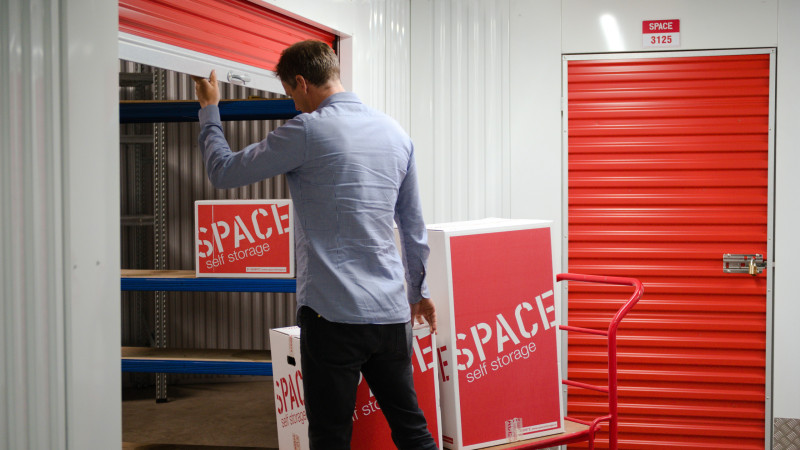Putting your belongings into storage can be a great solution when you’re downsizing, moving abroad, or simply decluttering for a cleaner space. But when items will be in storage for several months – or even years – it’s important to prepare them properly.
Long-term storage isn’t quite the same as short-term storage. Time, dust, moisture, and other things can all take a toll on your items if you’re not careful. That’s why planning ahead and packing smartly can make all the difference in keeping your belongings safe, clean, and in perfect condition.
In this post we’ll take a look at what to consider when preparing your items for long-term storage:
Choose the Right Type of Storage Unit
Not all storage units are created equal – especially for long-term use. If you’re storing items that are sensitive to heat, cold, or humidity (like electronics, antiques, artwork, or important documents), it’s worth investing in a climate controlled unit. These maintain a consistent temperature and humidity level year round, helping protect your belongings from warping, mold, and mildew.
Clean Everything Before You Store It
It might sound simple, but giving your items a good clean before putting them in storage is one of the most important things you can do.
Be sure to wipe down wooden furniture with a mild cleaner and polish, clean and condition any leather items, and make sure fabric upholstery is vacuumed and dry to prevent mildew.
With your appliances, you’ll want to ensure you empty and clean fridges, washing machines, and microwaves, and leave the doors slightly open to allow airflow and prevent odors or mold.
If you’re going to be storing clothing, wash and dry it all before storing. Even a small amount of moisture or body oil can lead to mildew. A little effort now will go a long way in preserving your belongings for the future.
Pack Smart with Long-Term Storage in Mind
For long-term storage, durability matters more than ever.
Use sturdy boxes (preferably plastic bins with tight-fitting lids) rather than cheap cardboard, which can collapse over time and absorb moisture. If stacking boxes, place the heaviest at the bottom and the lightest at the top to avoid crushing. Label clearly and label every side – trust us, your future self will thank you.
Wrap fragile items individually in bubble wrap or packing paper, and store them in tightly packed boxes to prevent shifting.
Use protective covers for furniture and mattresses, but opt for breathable fabric covers rather than plastic sheeting to prevent condensation.
Disassemble Larger Items
Disassembling furniture not only helps save space – it also reduces the risk of damage. Remove table legs, headboards, or shelves where possible. Store screws, bolts, and hardware in clearly labeled bags taped to the furniture or stored in a separate, easy-to-find container.
Wrap disassembled pieces in protective padding or moving blankets, and try to store everything vertically where possible to reduce surface contact and prevent warping.
Keep an Inventory

When storing items long-term, it’s easy to forget what you’ve packed months, or even years down the line.
Create a full inventory list of everything going into storage. You can do this on paper, a spreadsheet, or using storage inventory apps that let you even include photos. If you’re storing valuable items, this list can also be helpful for insurance purposes.
You might also want to sketch a quick “map” of your unit layout so you know where key items are located without digging through everything.
Allow for Airflow
Air circulation is your best friend in long-term storage. Don’t pack your unit floor to ceiling without leaving a little space between boxes and walls.
Try to avoid wrapping furniture in plastic wrap for long periods, as it can trap moisture and lead to mold or discoloration. Breathable fabric covers are a better long-term choice.
Check on Items Occasionally (If You Can)
If you’re nearby, it’s a good idea to visit your storage unit every few months to check that everything is still in good condition. Give things a quick wipe down, rotate boxes if needed, and make sure air can still circulate properly.
Even a short visit every so often can prevent long-term damage and catch issues early.
Insure Your Belongings
Be sure to talk to your provider to see what coverage they offer, or check whether your home insurance includes storage protection.
For peace of mind – especially if you’re storing high-value items like electronics, collectibles, or family heirlooms – insurance is a smart addition to your storage plan.
Planning Ahead
Long-term storage can be a stress-free, practical solution – as long as you prepare your items properly. From choosing the right unit to packing with care, the steps you take now will protect your belongings well into the future.
Whether you’re off on an extended adventure, clearing space at home, or storing sentimental items for the next chapter of life, long-term storage should give you confidence, not concern.
Need help finding the right storage solution for your needs? Get in touch with us today.

